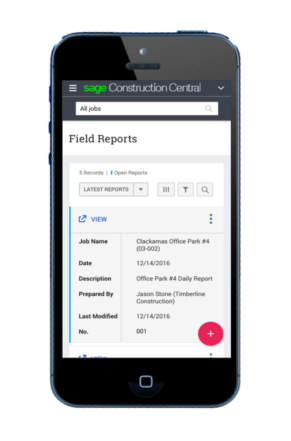
More and more heads are up in the cloud, or so concludes Consumer Economics’ recently released “IT Spending & Staffing Benchmarks 2017/2018.” Among other trends, the annual study found that capital expenditures and IT department hiring are essentially flat as a result of a shift to cloud computing platforms.
Construction is no exception to the cloud phenomenon.
In all, 85% of construction contractors use or plan to use cloud-based solutions according to a 2017 survey of nearly 1,300 firms performed by Associated General Contractors of America in collaboration with Sage Construction and Real Estate, a leading purveyor of cloud-based solutions. By comparison, a 2012 Sage survey found that only 16% believed cloud computing was important to their business.

Why the uptick? A main reason is the need for improved communication and greater efficiency on the job site. Another explanation is that many construction companies are confronting aging hardware and must decide between investing heavily in upgrades or taking the often less costly route of transitioning to cloud-hosted systems, said Dennis Stejskal, vice president, strategy and customer success, with Sage. “If machines have a faster solid-state drive, we’ll take that and push our product software to the limit,” he said. “So, companies are faced with the question of ‘Do I have to change hardware again or turn over operations to a hosting company?’”
Clearly, more firms are optioning the cloud alternative. However, Stejskal contends that users might be ignoring or omitting key components of cloud-based solutions and that non-users are missing the boat because of misunderstandings about the cloud. Following a discussion with BuiltWorlds, what follows is Stejskal’s key takes on the state of cloud-based computing.
Although hosted cloud computing is growing among construction contractors, some operations aren’t leveraging it to the full extent possible.
Some of the greatest growth in cloud adoption is occurring in the area of site operations — sharing of drawings and documents, daily field reporting, and so forth, according to Stejskal. “To some extent, we’re also seeing movement of data between back-office enterprise resource programs (ERP) and the cloud, allowing project managers and superintendents in the field to access and submit accounting-based information,” Stejskal said.

Among other advantages, stakeholders can access real-time data from any location via any number of mobile devices, including tablets and I-phones, promoting greater efficiencies and tighter integration with other software used by contractors.
However migration of back-office data — particularly sensitive information involving financials — to a cloud-based systems frequently lags behind implementation of operations-oriented applications because company management either doesn’t understand the concept of the cloud or is concern the cloud will allow access to proprietary information by those who shouldn’t be privy to it.
As a result, some contractors locate accounting personnel in trailers on site or expect a field member to drop by the office or call to access or supply the information required — neither an ideal means of promoting productivity and efficiency.
One solution, said Stejskal, is implementation of a private cloud configuration rather than a public cloud configuration. “With private data centers, company data is transmitted through a private pipeline to a single system equipped with dedicated software for storing information,” Stejskal said. Access to data is limited to those personnel designated by the contractor.

Market forces and demographics will prompt more construction companies to adopt cloud-based computing.
Many members of the construction industry are nearing retirement age. Others left the industry for other pursuits during the great recession. With construction activity once again accelerating, Stejskal predicts contractors that don’t use the clouds will reverse course as the labor market continues to tighten. “Construction has always been a laggard in adopting new technologies, but my guess is that is changing quickly as Millennials step in to fill open positions, “Stejskal said. “They like and are proficient with technologies such as tablets and iPhones, and construction firms are at risk if they don’t have the technological infrastructure in place to attract top talent.
Shrinking labor pools also are requiring that contractors become much more efficient in implementing their cloud strategy in order to compensate for the shortfall, Stejskal said. In many instances, companies are moving beyond simply applying cloud solutions to specific tasks, making sure they are evaluating the manner in which cloud solutions can integrate and improve communication within their entire organization, as well as with other building team members at work on a project.
Despite the advantages of cloud computing, and the market forces driving it, cooler heads may not always prevail due to unsubstantiated security concerns.
Problem no. 1 is that company management might believe it is relinquishing back-office data if the firm migrates it off premises to a cloud-based location, a concern compounded by worries the data may be less secure once it resides off site, said Stejskal.
In terms of security, “The difference between office- and data center-hosted security is like night and day,” says Stejskal. “Data centers provide redundancy in the firewall and scan incoming data for viruses. They also must conform to industry standards and are subject to security audits. By comparison, office-hosted data needn’t — and may not — engage in any measures.”
Hybrid systems can provide some contractors the best of both worlds – for now.
Stejskal refers to hybrid systems as transitional, incorporating methodologies that may lead to full adoption of cloud-based computing. In a nutshell, “hybrids provide mobile users with the connectivity to access premise software – meaning software that resides on a server in a contractor’s office or at a private-cloud hosting center,” he elaborated.
All told, Stejskal predicted that cloud-based software as a service (SaaS) applications will continue to proliferate, simplifying life on the job site, and that hosted cloud services will continue to grow in popularity among contractors wishing to outsource all or part of their IT operations and infrastructure.
This article was sponsored by Sage. For more on cloud-based AEC solutions, visit their website.


Discussion
Be the first to leave a comment.
You must be a member of the BuiltWorlds community to join the discussion.